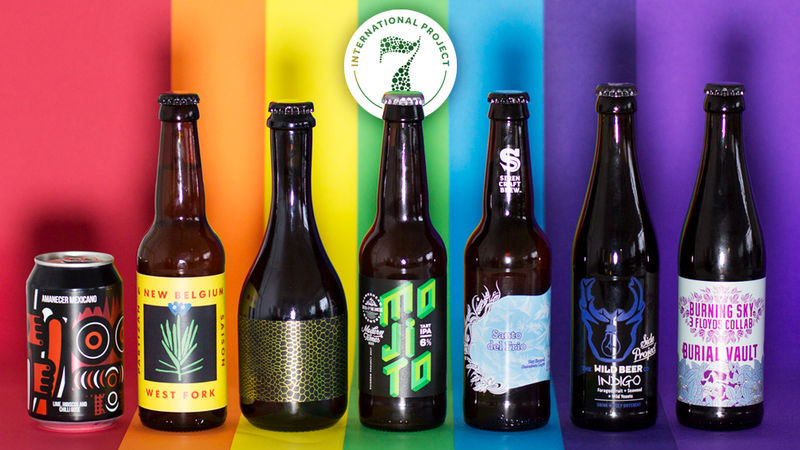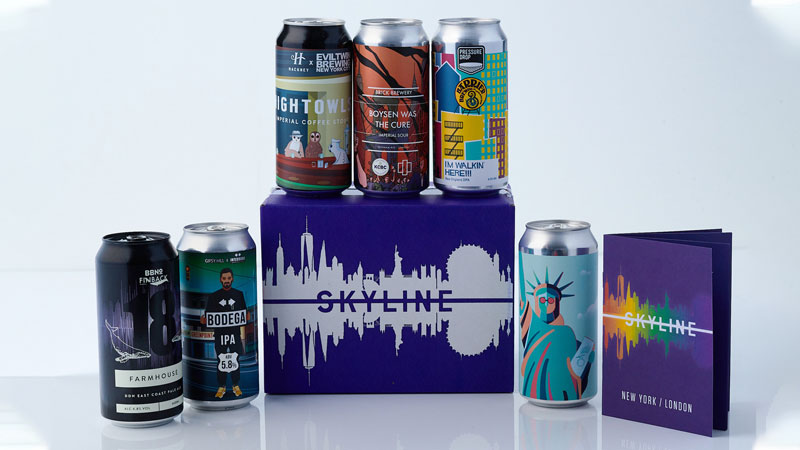The value of beer is more than the sum of its parts — that’s a given. While yeast is a fundamentally important organism almost across the board, and water is obviously necessary for life, when combined with barley and hops, the result is something that brings people together, exists beyond nations and cultures, and is bloody delicious. All of the above applies to brewing collaborations, too.
Though collaborations between breweries offer little financial benefit — they often cost at least one of the collaborating parties a sizable amount of money — there’s a lot to be gained from teaming up with like-minded people, including new knowledge, exposure to different markets, and intra-industry bonding, to name a few benefits.
Back in 2013, when Ryan Witter-Merithew was the head brewer at Siren Craft Brew, just outside London, he launched one of the very first collaborative projects of its kind: the International Rainbow Project. The idea was simple: Pick seven breweries (one for each color of the rainbow), and pair them with seven breweries from somewhere else in the world.

“It was just a thought I had one day,” says Witter-Merithew, who founded and now runs Casita Cerveceria, a contract brewing operation in Farmville, N.C. “I don’t believe Siren was but six months old, and I was becoming familiar with the beers and brewers in the U.K., and the idea started to form. It was mainly a way to try to creatively challenge people — and have some fun with it.”
With brewing collaborations, you get out what you put in, says Witter-Merithew. “You can phone it in and pose for photos, which I’ve done, or you can spend the day talking process and try to learn something to take back with you, which I’ve also done,” he says. “Every brewery does something different [from] how you would approach it, and so it can be really helpful to see it firsthand, ask questions, and pick up a trick or two.”
Darron Anley, the founder of Siren, says that the Rainbow Project has become a very significant piece of the brewery’s history so far. “What started as a fun idea,” he says, “grew into something that caught a lot of people’s imagination, ended up with great reach, and really put a spotlight on the U.K. brewing scene.”
The Rainbow Project may have started as a fun, interesting, and challenging idea, but it grew into a national phenomenon, with highly acclaimed breweries — such as 3 Floyds Brewing Company in Hammond, Ind., Firestone Walker in Paso Robles, Calif., New Belgium in Fort Collins, Colo., and Garage Project in Wellington, New Zealand — collaborating with some of the U.K.’s best breweries. What Witter-Merithew and Anley didn’t realize, however, was how influential it would end up being.
Bruce Gray, the founder of Left Handed Giant in Bristol, was speaking to Anley over a beer at last year’s London Craft Beer Festival, when Anley mentioned that he was thinking of disbanding the project. “He felt that it had run its course, and the breweries involved had lost the enthusiasm they had for it when they began,” says Gray, adding, “I have always had a huge respect for what Siren and the other breweries involved [in the Rainbow Project] achieved in taking small, independent U.K. breweries to a wider audience.” The conversation continued, and after a few beers, Gray says, he and Anley “concocted the idea of Left Handed Giant taking curatorship of the concept, and bringing the next generation of small U.K. breweries into the fold.”
Because Gray valued the effect that the Rainbow Project had on British brewing, he was keen to take the project on, and to continue promoting the spirit of collaboration to a new audience. “With the evolved concept of handing its stewardship over every three years to a brewery that was founded within the last three years,” Gray says, “it will provide a continual platform for each generation of U.K. producers to reach beyond our borders, to collaborate, to learn, to create friendships, and further the U.K. beer scene’s impact on the world beer scene.”

Others agree that the positive influence of the Rainbow Project can’t be understated. “I think that it has spawned a lot of projects of this nature,” says Jon Swain, the founder of London’s Hackney Brewery, which launched its own international collaboration, the Skyline Project, last summer. As additional examples, Swain cites Elusive Brewing’s Collabogedden, Brewdog’s Collabfest, Wylam Brewery’s and now Northern Monk’s Northern Powerhouse, and Fierce’s North Sea Bridges.
Swain explains that the impetus to start Skyline grew out of a trip to New York. “The community really stood out to me,” he says. “I was visiting KCBC, and they introduced me to Interboro, who in turn introduced me to LIC Beer Project. Then visiting Other Half, they sent me to Threes, who then sent me to Strong Rope. It felt exciting, welcoming, and connected. I wanted to feel the same in our city.”
Operating on a near-identical model to the Rainbow Project, and many other similar projects, Swain paired London breweries with similar breweries in New York, which then collaborated on beers that were launched at the 2019 London Craft Beer Festival. “We’ve had some great feedback about it,” says Swain. “I think it’s a project we can grow, and [it] will hopefully capture something about each city we take it to.”
Last October, Harbour Brewing in Cornwall announced its new Radius Project, a collaboration that explores the impact of terroir on beer. As with other recent brewery collaborations, Radius brewers are thrown together to make a beer for a communal launch. Like the Rainbow Project, which used the colors of the rainbow as jumping off points and inspiration for creative brewing, Harbour’s project encourages a broad range of styles. Each Radius beer will express its distinctive terroir by incorporating one or more ingredients sourced from within a 20-mile radius of the brewery where it was made.
“The beer scene is dominated by a couple of styles — mostly lagers and pales or IPAs,” says Adam Sargent, Harbour’s branding and content manager. “We love those types of beers, but we also want to broaden drinkers’ horizons, and give them more — and different — choices. Radius is about being a showcase of the diversity of what beer can be.”
Sargent points out that brewers spend a great deal of time in their facilities with their heads down, making beer. “Collaboration projects — whether it’s two brewers working on one beer together or a group of individual brewers working [with] a common theme — get everyone communicating and thinking differently, [and] you always come out of it more enriched,” he says. “As drinkers, we think it’s exciting to see how, in a somewhat homogenized market, a group of breweries all start out at the same point, then where they end up, and the journey they go on to get there.”
This story is a part of VP Pro, our free platform and newsletter for drinks industry professionals, covering wine, beer, liquor, and beyond. Sign up for VP Pro now!
